|
|
|
Sort Order |
|
|
|
Items / Page
|
|
|
|
|
|
|
| Srl | Item |
| 1 |
ID:
110271
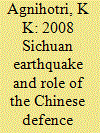

|
|
|
|
|
| Publication |
2012.
|
| Summary/Abstract |
The People's Republic of China has been afflicted by natural calamities right from its inception in 1949, including severe river flooding, excess snowfall, cyclones, tsunamis and earthquakes. The consequential human suffering is further aggravated by the heavy population density. The mammoth 2008 earthquake in Sichuan province and the resultant loss of life and property exposed the ill-preparedness of the Chinese government machinery like never before. Nevertheless, the Chinese State Council rose admirably to the occasion. The Peoples' Liberation Army (PLA) composed of military, armed police, militia and reserve troops was the single largest contributor to the emergency rescue, response and subsequent mitigation efforts. In the process, it encountered many obstacles, faced severe shortcomings, learnt valuable lessons and initiated measures to incorporate these lessons for better disaster preparedness in future. The PLA internalised disaster relief as one of its major tasks under the "military operations other than war" role. The situation in India-large population density and frequent occurrence of natural disasters-is similar to that of China. Thus, there are valuable lessons to be learnt from the Chinese experience of having suffered this earthquake and the methodology adopted, particularly by their armed forces, in disaster response, mitigation and capacity building for better management of mega disasters in future.
|
|
|
|
|
|
|
|
|
|
|
|
|
|
|
|
| 2 |
ID:
110279


|
|
|
|
|
| Publication |
2012.
|
| Summary/Abstract |
This article tries to examine the role played by the Army during a natural disaster. India's federal set-up tends to complicates issues and, quite often, politics dominates the humanitarian aspect, which leads to delays in the development of the army. This article is a case study of the Kosi flood of 2008 in Bihar, which was an outstanding example of civil-military cooperation. The article also analyses the successful efforts made by retired Army personnel for curbing the Naxal problems in the state. But the article also poses certain questions: Is the deployment of the army in humanitarian crises good for it? Will political controversies damage the credibility and effectiveness of the Army?
|
|
|
|
|
|
|
|
|
|
|
|
|
|
|
|
| 3 |
ID:
110272


|
|
|
|
|
| Publication |
2012.
|
| Summary/Abstract |
Geographic position, climatic features, and geological structures cause natural disasters in almost cyclical order in China. Man-made disasters such as the SARS epidemic add a new dimension to the over all woe of a nation which is home to 18.5 per cent of the world population. The paper explores the extent of the face lift achieved by the People's Republic of China (PRC) from once being known as the "Land of Famines" and the "Land of Death", and, in particular, the positive contribution of the People's Liberation Army (PLA) in the whole gamut of disasters. The findings highlight the otherwise avoidable chinks in the Chinese model..
|
|
|
|
|
|
|
|
|
|
|
|
|
|
|
|
| 4 |
ID:
110269
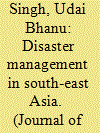

|
|
|
|
|
| Publication |
2012.
|
| Summary/Abstract |
South-east Asia is the epicentre of frequent disasters of varying intensity. The damage to life and property caused by these disasters is comparable to that caused by war. Disasters disrupt the national economy and social development. Besides, the world has shrunk and news about the hardship suffered by the people is rapidly disseminated. As such, the management of disasters has become a key concern of governments confronted with an increasingly aware civil society and a shorter reaction time. Often when disaster strikes, it impacts more than one country and sometimes the region as a whole. The intensity and the frequency of such disasters have prompted the ASEAN to evolve its own response mechanism. However, often the scale of the disaster is so huge that only an international response can meet the challenge. In such cases, the international community, acting through the United Nations and its various agencies and other inter-governmental and non-governmental bodies, has provided succour. Although disasters can be natural, technological and conflictrelated, this paper addresses only natural disasters in the region.
|
|
|
|
|
|
|
|
|
|
|
|
|
|
|
|
| 5 |
ID:
110275
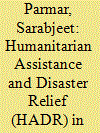

|
|
|
|
|
| Publication |
2012.
|
| Summary/Abstract |
Humanitarian Assistance and Disaster Relief (HADR) operations have attracted the attention of the global community in recent years. Building capabilities, interoperability and a conceptual framework for participation in these operations is gaining increasing urgency among Indian policymakers. The Indian armed forces have a wide experience of disaster relief operations both at home and abroad, where they have been the core of relief operations. Due to its sub-continental size, geographical location and its vulnerability to disasters, India has kept its forces ready to render assistance at short notice. In the six decades since independence, India has experienced a number of natural and man-made disasters such as floods, earthquakes, famines, industrial accidents etc. At the same time, India has partnered the global community in providing relief in affected regions. As India moves to occupy an important position in the global community, it is in the process of bolstering its capabilities to match the rising expectations. That India would play an important role
|
|
|
|
|
|
|
|
|
|
|
|
|
|
|
|
| 6 |
ID:
110270
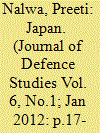

|
|
|
|
|
| Publication |
2012.
|
| Summary/Abstract |
The March 2011 triple disaster in Japan obligated a response from the US, its long-time ally. The US disaster assistance to Japan went beyond the customary nature of the countries' relationship, and was conspicuous for the scale of military involvement that was embedded in the US-Japan alliance. The success of the US asistance programme Operation Tomodachi is attributed to interoperability between the defence forces of the two allies. In so doing, the alliance which was originally meant for projecting hard power has assumed a new role which is in sync with the new meaning of 'security' as defined in the wake of the end of the Cold War. This new orientation makes it is necessary to revisit the theoretical understanding of military alliance. However, the success of Operation Tomodachi is likely to spur greater interoperability which in turn would enhance Japan's military modernisation.
|
|
|
|
|
|
|
|
|
|
|
|
|
|
|
|
| 7 |
ID:
110273


|
|
|
|
|
| Publication |
2012.
|
| Summary/Abstract |
The massive earthquake (known as the Tohoku earthquake) and the subsequent tsunami that struck Japan on March 11, 2011, and the following release of radiation from the Fukushima Dai-ichi nuclear power station, constitute one of the greatest disasters to strike Japan in recent times. This triple disaster falls within the risk profile of Japan's disaster management programme. There were no contributing factors that could not or should not have been predicted and accounted for. As it transpired however, Japan's disaster response management failed because of systemic weaknesses, that had been identified in previous similar events, including the 1995 Kobe-Hanshin earthquake. The inexperience of the governing Democratic Party of Japan (DPJ) and domestic political compulsions led them to withhold information from the public and this made them the target of accusations over the mishandling of a crisis of such gigantic proportions.
|
|
|
|
|
|
|
|
|
|
|
|
|
|
|
|
| 8 |
ID:
110276


|
|
|
|
|
| Publication |
2012.
|
| Summary/Abstract |
In recent years, the intensity of the occurrence of natural disasters has increased manifold. Responding to this, the Government of India has undertaken various measures to mitigate the impact of disasters. Even so, the response of the civil authorities is often found inadequate and the armed forces are called out to assist the civil administration. The armed forces never fail to respond in a prompt manner, but without proper data on various local resources, skills, essential services and equipment. Hence, there is a dire need of the armed forces to be trained in the field of disaster management to deal with disasters of various types.
|
|
|
|
|
|
|
|
|
|
|
|
|
|
|
|
| 9 |
ID:
110278
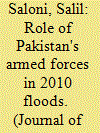

|
|
|
|
|
| Publication |
2012.
|
| Summary/Abstract |
When nature laid its wrath on Pakistan in July 2010, engulfing major parts of the country with devastating floods, it demanded that the nation stand tall. This led to emergence of the Pakistani army as the dominant national player in rescue missions. The army's role gave clear evidence of careful planning, optimal utilisation of resources, sharp foresight, and bold leadership. The army conducted and participated in numerous life-saving operations, and reinvented itself during one of the toughest times faced by this war-struck country. It involved itself in every aspect of the job, and rendered full support in terms of resources and rescue efforts. It helped in controlling the damage to a large extent thereby saving not only lives, but also the means of livelihood. In some ways, these events led to a shift in the previously held negative international opinion of the Pakistani armed forces.
This achievement of the Pakistani army is narrated as a case study that describes and compares the role of armed forces in disaster management and nation-building activities, across the globe. The importance of cooperation between civil administration and military is also discussed, especially with regard to such events where all the national organisations of a country need to work together to bring back peace and stability in the internal environment. Natural calamities can strike any continent or country at any point of time. The events of July 2010 in Pakistan only reinforce the importance and need for us to get our act together and use this experience to create an efficient framework to ensure effective disaster management.
|
|
|
|
|
|
|
|
|
|
|
|
|
|
|
|
| 10 |
ID:
110277
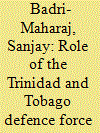

|
|
|
|
|
| Publication |
2012.
|
| Summary/Abstract |
A wealthy twin-island nation, Trinidad and Tobago has had few serious disasters to challenge its capacity to cope with such incidents. Although several plans for disaster management exist, these have remained largely th eoretical exercises. However, recent instances of devastating earthquakes in Haiti and Japan, with the accompanying tsunami in the latter, have prompted some steps towards an enhanced role for the Trinidad and Tobago Defence Force (TTDF) in disaster management. This paper will seek to outline the disaster management framework of Trinidad and Tobago and to highlight the role of the TTDF detailed therein. It will also give a brief outline of the practical experience of the TTDF in regional disaster management and highlight recent steps to improve capabilities. However, it will be shown that, despite these efforts, substantial capability gaps remain and limit the ability of the TTDF to perform its specified disaster management tasks.
|
|
|
|
|
|
|
|
|
|
|
|
|
|
|
|
| 11 |
ID:
110274


|
|
|
|
|
| Publication |
2012.
|
| Summary/Abstract |
An earthquake of the magnitude 6.9 on the Richter scale occurred in Sikkim and the neighbouring states of West Bengal, Assam, and Bihar on September 18, 2011. The tremors were felt in five other Indian states, besides affecting neighbouring Nepal, Bhutan, Bangladesh, and China. Although few lives were lost (111 in all) despite the high magnitude of the quake, primarily because its epicentre was in the remote and thinly-populated area of Mangan, significant lessons were learnt in its aftermath. One important lesson related to the difficulty of accessing the disaster-affected area because of numerous landslides, bad weather. The calamity once again highlighted the crucial role of the armed forces in the post-disaster relief operations. The armed forces located within Sikkim played a significant role in rescue and immediate relief. Although affected themselves, they were the first to respond and provided the succour to the victims within the crucial "golden hours", when other no other first responders of the state got activated. The authors, who visited the disaster areas and interacted with the community and the officials, undertook a research study of the earthquake and make several recommendations/suggestions in the article, which are likely to help the state in being better prepared for the management of such disasters in future. Some of the suggestions are targeted at the armed forces as well, as they are equally vulnerable to earthquake disasters in Zone V areas.
|
|
|
|
|
|
|
|
|
|
|
|
|
|
|
|
|
|
|
|
|